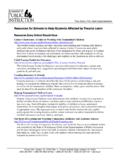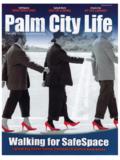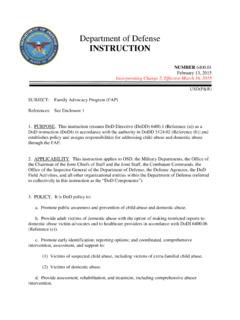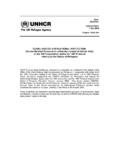Transcription of Mollie Michelfelder, LISW and Eileen Swoboda, LISW
1 Mollie Michelfelder, LISW and Eileen Swoboda, LISW Copyright 2012 Trauma Informed Care Stakeholders Group Training Subcommittee 1 Definitions Prevalence Impact of Trauma Trauma Informed Care Resiliency References Resources Copyright 2012 Trauma Informed Care Stakeholders Group Training Subcommittee 2 A traumatic event is one in which a person experiences (witnesses or is confronted with): Actual or threatened death Serious injury Threat to the physical integrity of self or another Responses to a traumatic event may include Intense fear Helplessness Horror Attachment (Marcenich, 2009) Copyright 2012 Trauma Informed Care Stakeholders Group Training Subcommittee 3 Prolonged exposure to repetitive or severe events such as child abuse, is likely to cause the most severe and lasting effects.
2 Traumatization can also occur from neglect, which is the absence of essential physical or emotional care, soothing and restorative experiences from significant others, particularly in children. (International Society for the Study of Trauma and Dissociation, 2009) - 4 I Copyright 2012 Trauma Informed Care Stakeholders Group Training Subcommittee Interpersonal violence tends to be more traumatic than natural disasters because it is more disruptive to our fundamental sense of trust and attachment, and is typically experienced as intentional rather than as an accident of nature. (International Society for the Study of Trauma and Dissociation, 2009) Copyright 2012 Trauma Informed Care Stakeholders Group Training Subcommittee 5 Trauma and traumatic events include personal and private experiences and public experiences.
3 Examples of personal and private events: Sexual assault Sexual abuse Domestic violence/interpersonal violence Witnessing domestic violence Examples of public trauma/traumatic events: Natural disasters War Community violence (Hopper, 2009) Copyright 2012 Trauma Informed Care Stakeholders Group Training Subcommittee 6 Perception of trauma varies vastly among individuals. Trauma is something that overwhelms our coping capacity Affects the whole self Physical Emotional Intellectual Spiritual Copyright 2012 Trauma Informed Care Stakeholders Group Training Subcommittee 7 A report of child abuse is made every ten seconds in the United States. (Childhelp, 2013) Children who experience child abuse and neglect are 59% more likely to be arrested as a juvenile, 28% more likely to be arrested as an adult, and 30% more likely to commit violent crime.
4 (Child Welfare Information Gateway, 2006) Trauma histories are pervasive among youth in America (especially youth from diverse cultural backgrounds). (Marcenich, 2009) Children with disabilities are more likely to experience neglect than children without disabilities. (Child Welfare Information Gateway, 2006) Copyright 2012 Trauma Informed Care Stakeholders Group Training Subcommittee 8 More than 1 in 3 women ( ) and more than 1 in 4 men ( ) in the United States have experienced rape, physical violence, and/or stalking by an intimate partner. (CDC,2013) Nearly 80% of female offenders with a mental illness report having been physically and/or sexually abused. (Marcenich, 2009) The majority of clients served by public mental health and substance abuse service systems are survivors of trauma.
5 (Mueser et al, 1998) Seventy-five percent (75%) of women and men in treatment for substance abuse report trauma histories. (SAMSHA/CSAT, 2000) Copyright 2012 Trauma Informed Care Stakeholders Group Training Subcommittee 9 ACE STUDY Research study of 17,000 participants. Adverse Childhood Experiences (ACEs) can affect an individual s physical and emotional health throughout the life span. Trauma/traumatic experiences are far more prevalent than previously recognized. Copyright 2012 Trauma Informed Care Stakeholders Group Training Subcommittee 10 V. J. Felitti, MD Kaiser Permanente R. F. Anda, MD, MS Centers for Disease Control and Prevention Copyright 2012 Trauma Informed Care Stakeholders Group Training Subcommittee Early Death Disease, Disability, & Social Problems Adoption of Health-Risk Behaviors Social, Emotional, & Cognitive Impairment Disrupted Neurodevelopment Adverse Childhood Experience 11 Activation of survival responses: Fight Flight Freeze Submit Shutting down of non-essential tasks.
6 Rational thought is less possible at this time. (Hopper, 2009) Copyright 2012 Trauma Informed Care Stakeholders Group Training Subcommittee 12 Prolonged exposure to trauma and/or repetitive traumatic events MAY: Cause an individual s natural alarm system to no longer function as it should. Create emotional and physical responses to stress. Result in emotional numbing and psychological avoidance. Affect an individual s sense of safety. Diminish an individual s capacity to trust others (Hopper, 2009) Copyright 2012 Trauma Informed Care Stakeholders Group Training Subcommittee 13 The following responses to trauma/traumatic events are components of Posttraumatic Stress Disorder (PTSD): Hyperarousal: nervousness, jumpiness, quickness to startle.
7 Re-experiencing: intrusive images, sensations, dreams, memories Avoidance and Withdrawal: feeling numb, shutdown or separated from normal life pulling away from relationships and/or activities avoiding things that trigger memories of trauma/s Copyright 2012 Trauma Informed Care Stakeholders Group Training Subcommittee 14 Safety and Stabilization Processing of Traumatic Material Reconnection and Reintegration Copyright 2012 Trauma Informed Care Stakeholders Group Training Subcommittee 15 Attention to basic needs including: connection to resources self-care identification of support system Focus on the regulation of emotion and develop capacity to self-soothe. Education on trauma and treatment process.
8 Copyright 2012 Trauma Informed Care Stakeholders Group Training Subcommittee 16 The primary goal of this phase of treatment is to have the patient acknowledge, experience and normalize the emotions and cognitions associated with the trauma at a pace that is safe and manageable. (Luxenberg, Spinazzola, Hildago, Hunt and van der Kolk, 2001) Copyright 2012 Trauma Informed Care Stakeholders Group Training Subcommittee 17 Development of a firm or a new sense of self Development of healthy and supportive: Friendships Intimacy Spirituality Copyright 2012 Trauma Informed Care Stakeholders Group Training Subcommittee 18 Aims to avoid re-victimization.
9 Appreciates many problem behaviors began as understandable attempts to cope. Strives to maximize choices for the survivor and control over the healing process. Seeks to be culturally competent Understands each survivor in the context of life experiences and cultural background. (Alvarez and Sloan, 2010) Copyright 2012 Trauma Informed Care Stakeholders Group Training Subcommittee 19 Resiliency is the capability of individuals to cope successfully in the face of significant change, adversity, or risk. The capacity changes over time and is enhanced by protective factors in the individual and environment. (Stewart et al.,1991 as cited by Greene and Conrad, 2002) 20 Copyright 2012 Trauma Informed Care Stakeholders Group Training Subcommittee There are behaviors, characteristics and qualities inherent in some personalities that that will assist in recovery after exposure to a traumatic event, these are called, protective factors.
10 21 Copyright 2012 Trauma Informed Care Stakeholders Group Training Subcommittee A reliable support system (friends, family). Access to safe and stable housing. Timely and appropriate care from first responders. 22 Copyright 2012 Trauma Informed Care Stakeholders Group Training Subcommittee Good Self care such as: sleeping at least eight hours a night. Eating nutritious foods. Exercise Practicing good boundaries. Using positive coping mechanisms verses negative coping mechanisms. 23 Copyright 2012 Trauma Informed Care Stakeholders Group Training Subcommittee A vigorous approach to life A sense of meaningfulness An internal locus of control (vs.)













